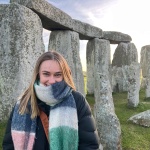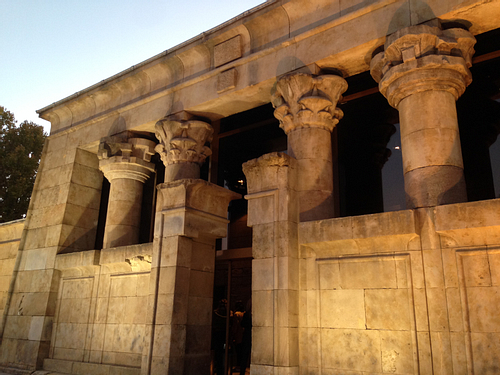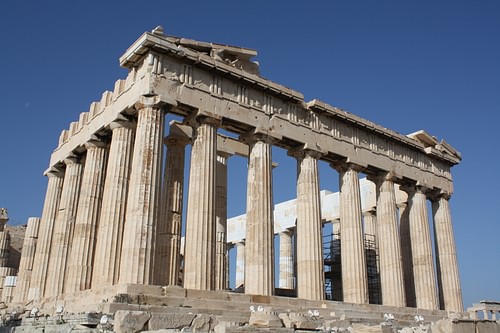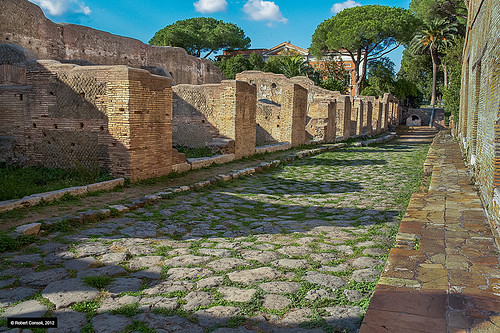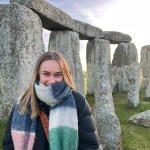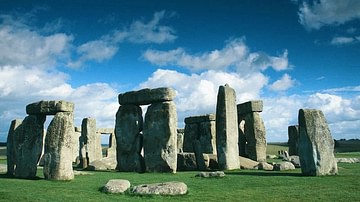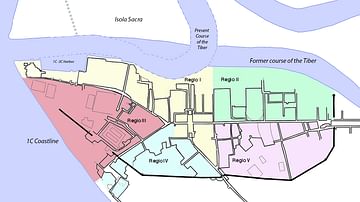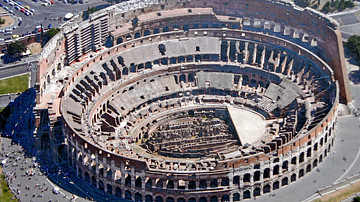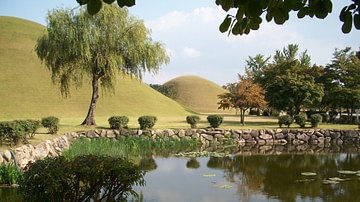In this interview, Ancient History Encyclopedia is talking to Simon Young, the founder of Lithodomos VR, which is a company based in Melbourne, about their new platform Ancient World!
Simon (Lithodomos VR): Hi, Kelly. It is great to be here, and I am so happy to be able to chat with you today about Lithodomos and about Ancient World.
Kelly (AHE): So, do you want to tell us a little bit about Ancient World?
Simon: We are so excited that we finally are launching our Ancient World platform. So basically, it has 22 virtual tours of heritage sites and ancient sites that have, at its base, a 360-degree reconstruction. The great thing about them is that you can see them on any device. Like all of our content, we have partnered with archaeological and historical experts, and also with our leading 3D artist team to create these incredible reconstructions.
Kelly: Brilliant! Do you want to tell us a little bit about Lithodomos as a company and what it is today?
Simon: Lithodomos has emerged as a world-leading hybrid archaeology CGI studio that focuses on designing and creating historically accurate 2D and 3D reconstructions of culturally significant heritage sites. So, because it was founded by archaeologists, we value above all authenticity but also combine it with creative direction and state of the art technology to recreate digital heritage sites around the world that are understandable for everybody.
Kelly: Awesome! So, it is completely available for students, younger learners, younger lovers of history, and seasoned archaeologists and ancient historians.
Simon: Exactly. We always say that whether you are a fan of history or a visitor to the site, a student, a teacher, tour guide, or cultural heritage professional, you will be amazed by the experience.
Kelly: Can you tell us a bit about the process of making each site?
Simon: Absolutely. What we do first is a very rough draft, blocks of cubes that represent buildings or cylinders that represent trees. We kind of render out a very rough draft to begin with, and then we jump into virtual reality and have a look around. As a researcher or an archaeologist, you see that tree and you start wondering, OK, what species was that tree, was it really that tall? What kind of leaves did it have? What was on the ground in front of me? All that kind of spatial visual stimulus makes us, as the creators, want to fill in the gaps, but not with imagination but with research.
Kelly: So obviously have to take into consideration that topography changes, right?
Simon: Exactly, exactly. That is another thing that comes up. It is amazing the things that we discover when we are doing the reconstructions, new archaeological discoveries, or new observations. There is all this philosophy, technical construction, and research that goes into it, but the end result is immediately understandable to anyone.
Kelly: Will you have any sort of extra resources available to people that do want to know more?
Simon: Absolutely. The great thing about Ancient World is that apart from the 360 reconstructions, which form the basis of each point on the tours, there is a whole range of infographics, maps, and additional information within the tool that visitors can refer to. Probably the most exciting thing that we have added to the experiences, rather than having the live tour guide on-site with the virtual reality headset, we have taken the live guide and we have recorded their narrative and their audio.
Kelly: Do you have a favourite site out of all the ones that you have worked on?
Simon: I love them all! They are all very different and they are all excellent.
Kelly: I was on your website and I noticed there were no reconstructions of Egypt. Is there any reason why, or do you have any plans in the future?
Simon: We certainly do have plans for the future. We have one viewpoint at the moment in Egypt. It is in our library and we are looking at expanding the Egypt tour later on. Strangely enough, this point from Egypt comes from Madrid.
Kelly: Right! How is that possible?
Simon: Well, back in the I think it was the 1960s CE, when they were building the Aswan Dam, there was a particular temple, the Temple of Debod, which was going to be submerged by this dam. So the Spanish government offered to rescue the temple and they moved it block by block, to Madrid and reconstructed it. In the center of Madrid is an Egyptian temple. So, we did a tour of Madrid.
Kelly: And then you saw the Egyptian temple!
Simon: Yes. And the Egyptian temple is one of the viewpoints. We recreated the Egyptian temple in its original location in Egypt. If you jump on the tour of Madrid, you will visit Egypt.
Kelly: Let us go back to the beginning of Lithodomos. When did you start the project?
Simon: Well, we started Lithodomos in 2016 CE. I was studying for my Ph.D. in Greek and Roman archaeology, specializing in Turkey. I was very interested in 3D reconstruction technology. I started playing around with various programs to see what the ancient world would have looked like. I thought, maybe if I use archaeological plans, elevations, and research, I could get it more or less accurate. You have seen the classic picture of an archaeologist on their hands and knees in an excavation with a brush, but they also have a pencil and a piece of paper and a ruler, and they are measuring everything exactly where they found it and plotting it to a plan. We use these site plans and elevations as a basis for our model, so I loaded these into a 3D program called Blendr, and then I thought, 'what would happen if I took a virtual reality headset and put these models into the virtual reality'? I remember the day that I put on the headset and I stepped into the Roman Forum, I went, 'oh, my God, this is incredible', then I started showing people, and they were amazed as well.
Kelly: I can imagine!
Simon: One thing led to another, and in 2016 CE, I met a guy at a bachelor party, and I told him about what I was doing, and we thought, there could be a business in this. I went away and did a bit of research to see how many people, for example, visit the Roman Forum every year. And I thought, you know, a few thousand at least. It turns out it is around nine million. I thought, 'would it not be great if we had a virtual reality device that you could use on-site to see what it used to look like?' On the basis of this, we raised some money in early 2017 CE here in Melbourne, then we spent the next few years traveling around the world, visiting archaeological sites, meeting up with site directors, museum curators, and creating a digital library of over 500 virtual reality scenes of the ancient world.
Kelly: That must have been amazing to meet these people that actually work on the sites!
Simon: It was so surreal. In one week one of these colleagues was driving me around on his Vespa around the Colosseum, to a meeting with the director of the Colosseum to show him our reconstructions. Then the following week at King Herod's palace in Jerusalem, we were sharing our reconstruction of the palace with the district archaeologist of Jerusalem.
Kelly: I mean, that is crazy! You must have met some amazing people!
Simon: Absolutely, absolutely amazing people all around the world. I mean, archaeologists are incredible people, anyway! It is pretty safe to say that we are not in it for the money, but for the love of the ancient world, and that is definitely what drives me.
Kelly: I think you can see that in the work though. You can definitely see the amount of time and effort and love that has gone into it. When you were in Europe, did you already have your plan for what sites you wanted to do? Or while you were there, did you discover more?
Simon: Well, we took a very pragmatic approach to it. We thought the best way to go about it would be to speak to the local tour guides, because in any city, for example, let us take Ostia, tour guides know the best spots because they have been doing it for years. We consulted very heavily with local tour guides and the established routes of local tour guides really drove what we recreated.
Kelly: Did you already have the idea to have a tour guide narrate the VR experience before that, or did that come to you while you were talking to them?
Simon: Well, the first iteration of the VR deployment was headsets on-site with a real tour guide. The big issue was that at that time, VR headsets were a bit clunky, and the technology was pretty hard to assemble, and batteries would die. Not everyone has access to a headset and not everybody feels comfortable going into virtual reality. So we thought, 'why not unlock the content and make it available cross-device?' So that is what we are working on now; our new platform called Ancient World.
Kelly: While you were doing the reconstructions, obviously you worked with off-site plans and you got as much detail as possible. How much of it was artistic liberty versus actual archaeological evidence?
Simon: Well, first and foremost, I am an archaeologist, so all of our reconstructions follow a really long tradition of reconstruction from the physical record. We never use our imagination to fill in the gaps. We use parallels if necessary, and if there is a level of uncertainty, we do our very best to do what we think is the most plausible reconstruction for those occasions. We drop this virtual camera onto this GPS coordinate and then we look at what is very close to you, what is a medium distance, what is far away, and what is invisible from view because we only create what you can see from that point.
Kelly: Which makes complete sense, because what is the point of doing more work if no one can see it?
Simon: Exactly. We put a lot of effort into the small details right in front of you. There is a lovely view in the Palatine Hill palace overlooking a garden on the so-called Domitian Stadium, and there's a wax tablet right in front of you. There's a stylus and there's a little bit of love poetry on the wax stylus from a graffiti in Pompeii. So that is rendered out lovingly in a lot of detail because it is so immediate.
Kelly: That would make it feel a lot more real as well.
Simon: It is kind of like a mental trick. Because once you see something of very high detail, very close to you, your brain is ready to accept everything. So that dandelion looks so real, then that temple 500 metres away must have the same level of detail! Of course, when we do move the camera in, we render out everything into high-level detail as you get there, but only when you get there. It is all about that place and time, which informs the entire recreation.
Kelly: Is there a criterion that the sites need to meet for you to be able to recreate them?
Simon: We generally choose sites with a high visitor volume. The top two most visited archaeological sites in the world are the Parthenon and the Colosseum, so you will see that those are on the top of our list, and we call those big sites. Then we have our medium sites and our small sites. We have been choosing the most visited sites, that is where the most interest is, for people who want to visit. But we are not limited by that. Another great thing about Ancient World is its educational value.
Kelly: Definitely! I was going to say this could work in schools and universities and for people that are aware of the top two popular sites, but unaware of the rest.
Simon: In this world of lockdown, it is a challenge to keep students engaged and interested. So Ancient World, due to its extremely interactive user interface, is a great tool that many teachers have used to get students to work independently with supervision. It can keep them interested!
Kelly: We may not be able to actually travel for some time, so it is nice to know that we do have the option to explore from the comfort of our own home. I know you have got ancient Athens, ancient Rome, do you have any plans of doing pre-classical periods, for example, Mycenaeans, Minoans, those kinds of people.
Simon: Yes, it is an interesting moment in archaeological history. We have done Stonehenge, we have done Cromeleque, which is in Portugal, and also a few recreations in Cordoba, but we have not gone into the early Iron Age or the Bronze Age.
Kelly: As we were talking before about changes in topography, I noticed you have Ostia. How did you work with the changing of the coastline?
Simon: That was a fascinating project because as you might know, when you go to Ostia today, you get to the end of the site and you go to the Porta Marina and you expect there to be the sea, and there are this ugly highway and fields as far as you can see. It is really quite stunning because the viewpoint matches the archaeology of the site so, so carefully. When you have got your tablet there, and you hold it up to the Porta Marina, it matches, and you can just pan around, and you see the sea and the boats instead of the highway. You immediately get this sense of the changing topography.
Kelly: Do you have anything that you are working on that you can tell us about?
Simon: So, we are not just ancient, I have to say. We recently released a tour of Colonial Hobart which, is a little bit closer to home for us. We also have in the pipeline, Málaga, in the time of the childhood of Picasso. So, this is the Málaga that Picasso saw as he was growing up before he went to France. So that is coming up very soon.
Kelly: That is very exciting! I did see that you also have Renaissance sites as well. What made you want to do Renaissance sites, after being an archaeologist of ancient Greece and Rome?
Simon: Once we had sunk our teeth into the ancient Greek and Roman world, we realised the techniques that we use for recreating archaeological sites are very easily transferable to other periods in history. Using plans, elevations, paintings, and engravings, these form the basis of reconstructions of more recent sites like Renaissance Madrid, Hobart, and Málaga.
Kelly: Brilliant. I love it. Fantastic. So apart from this digital platform of reconstructions, do you work with museums or anyone else other than just your own company?
Simon: Yes! In fact, one exciting development within Lithodomos is the expansion of our product portfolio. So now we are working on 360-degree cinema installations, tablet interactive displays for artifacts, audio-visual guides for museums that incorporate our 360 reconstructions, and the museum's local guide as an audio tour to make it really easy for museums to upgrade their technology.
Kelly: Brilliant! Thank you so much for joining me, it has been a pleasure.
Simon: It has been entirely my pleasure. Thanks.
